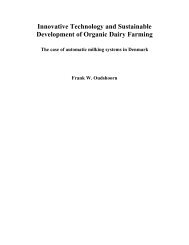Validation of Calibration Equations Developed ... - Automatic Milking
Validation of Calibration Equations Developed ... - Automatic Milking
Validation of Calibration Equations Developed ... - Automatic Milking
Create successful ePaper yourself
Turn your PDF publications into a flip-book with our unique Google optimized e-Paper software.
Abstract<br />
The average dairy cow herd size in Denmark is increasing and with it the consequences <strong>of</strong><br />
erroneous decisions in the production. Precision farming can help control costs and<br />
maximize the revenue and is <strong>of</strong> increasing interest in modern agricultural business. Feeding<br />
is one <strong>of</strong> the major costs in dairy production and the subject <strong>of</strong> development <strong>of</strong> precision<br />
methods and tools.<br />
In this report is the precision <strong>of</strong> a newly introduced method for prediction <strong>of</strong> pasture yield<br />
evaluated. The measurement equipment, called C-Dax Pasture Meter®, estimates dry matter<br />
(DM) yield from sward height and has, in a previous study, been calibrated under Danish<br />
conditions. The aim <strong>of</strong> this report is to validate the calibration equations found in that study.<br />
<strong>Validation</strong> was undertaken with independent data collected in a separate field trial in the<br />
same grazing project as the calibration trial. Sward height measurements were paired with<br />
harvested DM yield. The difference between yield predicted, by the previously developed<br />
calibration equations, and the actual DM yield harvested was evaluated. Three calibration<br />
equations were validated: 1) one for early season predictions (i.e. before mid July), 2) one<br />
for late season predictions (i.e. after mid July) and 3) one without inclusion <strong>of</strong> seasonal<br />
effects. Between 7-27% <strong>of</strong> the predictions were within ±10% <strong>of</strong> the actual yield, which<br />
indicates a low precision <strong>of</strong> the calibration equations and the need for further calibration <strong>of</strong><br />
the prediction equations. Precision was, however, positively influenced if yield was predicted<br />
from sward heights that are within the same interval as the calibration observations were<br />
made within. The results further indicate that the precision is positively influence by the use<br />
<strong>of</strong> seasonal calibration equations. The calibration equations are not recommended for<br />
practical implementation due to this unsatisfactory precision <strong>of</strong> the predicted pasture yield.<br />
2




